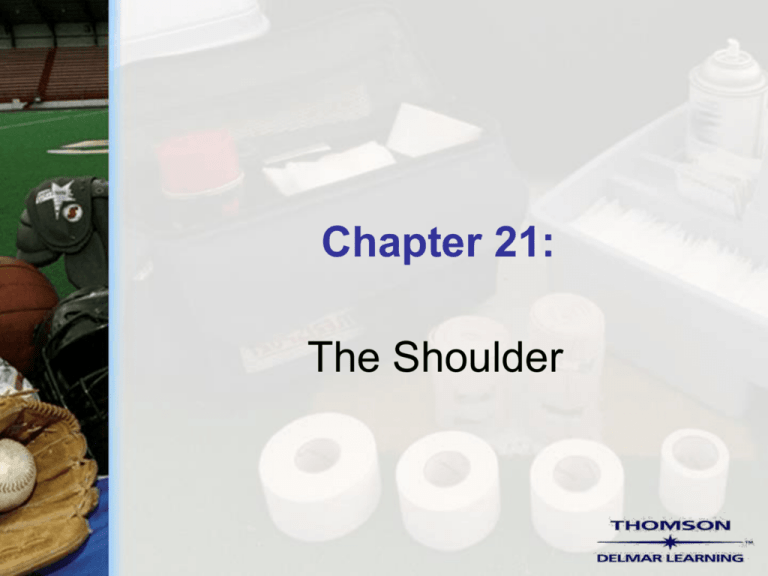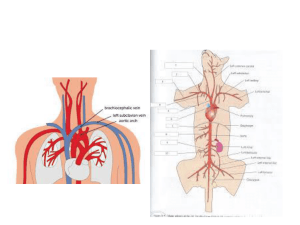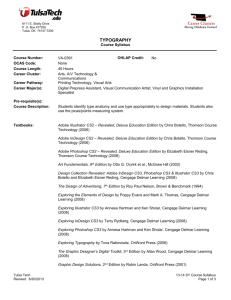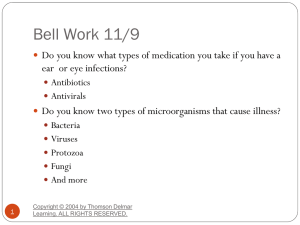
Chapter 21:
The Shoulder
Common Injuries
Impingement
syndrome
Rotator cuff
tears
Muscle strains
Tendonitis
Biceps tendon
rupture
Dislocation
Glenoid labrum
injuries
Multidirectional
instabilities
Acromioclavicular separation
Brachial plexus
injury
Fractures
Copyright ©2004 by Thomson Delmar Learning. ALL RIGHTS RESERVED.
2
Shoulder
Treatment/Rehabilitation
Taping and exercise can help deal
with injury and potential injury to the
shoulder.
Copyright ©2004 by Thomson Delmar Learning. ALL RIGHTS RESERVED.
3
Humeral Head Relocation
This procedure helps with humeral
head stability. The left thumb
provides a posterior glide to the
humeral head as the short stretch
tape is applied.
Copyright ©2004 by Thomson Delmar Learning. ALL RIGHTS RESERVED.
4
Corner Stretching
Standing in a corner, with hands
supporting against both wall
surfaces, lean forward to stretch the
pectoral muscles.
Copyright ©2004 by Thomson Delmar Learning. ALL RIGHTS RESERVED.
5
Horizontal Stretching
The stretch pictured here will help
stretch the muscles on the back
side of the shoulder.
Copyright ©2004 by Thomson Delmar Learning. ALL RIGHTS RESERVED.
6
Shoulder Muscle Stretches
With a towel used as shown in text
Figure 21-17, the right shoulder is
stretched into an internally rotated
position.
Copyright ©2004 by Thomson Delmar Learning. ALL RIGHTS RESERVED.
7
Shoulder Adduction
To strengthen shoulder adductor
muscles, use an elastic band
attached to a fixed object, and pull
downward toward the body.
Copyright ©2004 by Thomson Delmar Learning. ALL RIGHTS RESERVED.
8
Deltoid Muscle
Strengthening
Step on one end of an elastic band,
then pull straight up close to the
body and hold for 5 to 10 seconds.
Copyright ©2004 by Thomson Delmar Learning. ALL RIGHTS RESERVED.
9
Internal Shoulder Rotators
With the arm in a handshake
position, pull an elastic band across
the front of the body.
Copyright ©2004 by Thomson Delmar Learning. ALL RIGHTS RESERVED.
10
External Shoulder Rotators
Start with the arm in a position that
crosses the body. Then pull an
elastic band outward as the arm
moves into a handshake position.
Copyright ©2004 by Thomson Delmar Learning. ALL RIGHTS RESERVED.
11
Pectoralis Major
Stand with the arm extended and
hand externally rotated against a
wall. Gently rotate the body to
stretch the muscle.
Copyright ©2004 by Thomson Delmar Learning. ALL RIGHTS RESERVED.
12
Trapezius
While sitting, hold onto the table
edge and stretch away.
Copyright ©2004 by Thomson Delmar Learning. ALL RIGHTS RESERVED.
13
Deltoid Muscle Abduction
Stand sideways against a wall, then
isometrically lift upward with the
forearm against the wall. Hold 5 to
10 seconds.
Copyright ©2004 by Thomson Delmar Learning. ALL RIGHTS RESERVED.
14
Shoulder Extension
To strengthen the muscles used for
shoulder extension, pull an elastic
band with the arm moving from a
forward position to the side of the
body.
Copyright ©2004 by Thomson Delmar Learning. ALL RIGHTS RESERVED.
15
Special Tests
Certain tests can be performed
that aid in the evaluation of injury.
Copyright ©2004 by Thomson Delmar Learning. ALL RIGHTS RESERVED.
16
Hawkins Impingement Test
With the arm and elbow flexed to 90
degrees and the arm rotated
internally, apply overpressure to
internal rotation. Anterior shoulder
pain indicates rotator-cuff
tendonitis.
Copyright ©2004 by Thomson Delmar Learning. ALL RIGHTS RESERVED.
17
Neer’s Impingement Test
Passively flex the arm to end range
and apply gentle overpressure.
Anterior shoulder pain indicates
rotator-cuff tendonitis.
Copyright ©2004 by Thomson Delmar Learning. ALL RIGHTS RESERVED.
18
Crossover Impingement
Test
Passively adduct the arm horizontally
to end range. Pain in the AC joint is
a positive sign for rotator-cuff
tendonitis.
Copyright ©2004 by Thomson Delmar Learning. ALL RIGHTS RESERVED.
19
Rotator Cuff Injury
Shoulder hiking during active
abduction is an indication. The
drop-arm sign is pain and loss
of control in midrange as the arm
is lowered.
Copyright ©2004 by Thomson Delmar Learning. ALL RIGHTS RESERVED.
20
Supraspinatus Muscle
The supraspinatus manual muscle
strength test has the arm lifted,
thumb pointing down. A downward
force is a test for weakness
(compare to other side).
Copyright ©2004 by Thomson Delmar Learning. ALL RIGHTS RESERVED.
21
Gilchrist’s Sign
With a fully elevated arm holding
2 pounds, lower the arm (palm up).
A painful click or snap at 90 degrees
indicates biceps long-head
dislocation/subluxation.
Copyright ©2004 by Thomson Delmar Learning. ALL RIGHTS RESERVED.
22
Speed’s Test
With shoulder flexed to 90 degrees
(palm up), apply downward
pressure. Pain in the bicipital
groove indicates biceps long-head
tendonitis.
Copyright ©2004 by Thomson Delmar Learning. ALL RIGHTS RESERVED.
23
Clunk Test
With the subject supine, passively
abduct the arm with one hand while
bouncing the humeral head with the
other. A click or pop may indicate a
glenoid labral tear.
Copyright ©2004 by Thomson Delmar Learning. ALL RIGHTS RESERVED.
24
Sulcus Sign Test
With the shoulder relaxed, hold the
elbow and distract the arm
inferiorly. A gaping between the
lateral acromion and humeral head
indicates inferior shoulder
instability.
Copyright ©2004 by Thomson Delmar Learning. ALL RIGHTS RESERVED.
25
Posterior Glide Test
With the subject standing, brace the
posterior shoulder while pulling the
anterior superior humerus.
Excessive movement indicates
posterior gleno-humeral instability
(compare to other side).
Copyright ©2004 by Thomson Delmar Learning. ALL RIGHTS RESERVED.
26
Feagin’s Test
With the subject’s arm resting on
the clinician’s shoulder, gently pull
down at the shoulder. Excessive
movement indicates inferior
glenohumeral instability (compare
to other side).
Copyright ©2004 by Thomson Delmar Learning. ALL RIGHTS RESERVED.
27
Anterior Apprehension Test
With the arm at 90 degrees
abduction and the elbow at 90
degrees, gently apply external
rotation. A reaction of apprehension
and possible instability indicates
anterior shoulder instability.
Copyright ©2004 by Thomson Delmar Learning. ALL RIGHTS RESERVED.
28
Acromioclavicular
Shear Test
With arms at the side, squeeze with
both hands between the anterior
and posterior shoulder. Pain
indicates a sprain of the AC joint.
Copyright ©2004 by Thomson Delmar Learning. ALL RIGHTS RESERVED.
29
Roos Test
With arms in the position shown in
text Figure 21-29 A and B, the
subject opens and closes the hands
once per second for a minute.
Tingling in the arms and hands
indicates thoracic outlet syndrome
(TOS).
Copyright ©2004 by Thomson Delmar Learning. ALL RIGHTS RESERVED.
30










